Turimaso
By Gorilla Doctors Staff on Wednesday, January 6th, 2010 in Uncategorized.I received an alarming call Thursday morning from Elisabeth, our veterinary technician with RDB (the Rwandan wildlife authority). There was a 6.5 year old female gorilla in Pablo group with a snare on her left wrist. Trackers found her trailing a long rope snare in the morning and were able to cut most of the trailing bit away, but the noose was still tight on her wrist. Trackers were watching her closely – so far there was no wound and she was eating normally, but reports were that she was favoring her left arm when she walked. The next step was to talk with Felix and Katie from Karisoke, and Prosper from RDB to determine when was the best time to attempt an intervention – to attempt to anesthetize her to remove the snare. We all agreed that tomorrow Dr. Jean Felix and I, along with the most experienced trackers and Felix, would go to the group ready for an intervention. This would be my first field anesthesia with a wild gorilla. I was nervous and excited at the same time, and really wanted it to go well. The longer the snare stayed on her wrist, the greater the probability of complications (loss of blood supply to her hand, wounds at the snare site leading to infection, etc.).
Jean Felix and I went through the field bags, making sure we were ready for anything – all anesthetic drugs and reversers, emergency drugs, suture should there be a wound, fluids, antibiotics, oxygen and ET tubes… We went over the procedure several times out loud. We felt like we were as ready as we could be.
Pablo group is the largest gorilla group with nearly 50 individuals, including several silverbacks and several more black back males (and 2 new babies this month!). Cantsbe is the leader, one of the last animals left from the Dian Fosse times. He is a strong leader, and does not put up with threats to his group, especially snares. He has had years of experience, and knows well that snares are a huge threat to his family. We knew it might be difficult to isolate Turimaso, and to make matters worse her mother left the group several years ago, and now she tended to stay near Cantsbe. We had to trust that the trackers would keep us safe.
Dr. Jean Felix and I left MGVP Headquarters and picked up Felix at Karisoke Headquarters at 6am. We had hired 4 porters for the equipment, and would have 4 of the best trackers with us. In addition ORTPN had put together a snare patrol to go out with us to search for snares in the area Turimaso had be caught in hers. It was a large group as we headed up into the forest, and all knew we must be quiet, and communicate well. All radios were turned to a separate channel used only for situations like this one – where we must be able to hear each other clearly. We walked through the forest, single file, for about an hour, the tension palpable. At one point a group of about 6 peeled off to search for snares.
Advance trackers had already found the group. Turimaso still had the snare, and was not using that arm. She was in a good position for darting, according to those trackers. Felix, Dr. Jean Felix and I, following the main tracker for the group, moved quietly toward the gorillas to assess the situation before preparing the dart. Just as we were nearing Turimaso the screams started, and she ran past us with 3-4 females and juveniles after her. They had seen the snare and were trying desperately to get it off of her, even biting her in their efforts. The whole group became very excited, and we lost track of Turimaso in the confusion. She was somewhere in an area of dense foliage on a steep slope. We looked for over an hour, up and down the slope, all the time surrounded by gorillas, but could not find her. She was likely frightened, in pain, and hiding. We called in reinforcements and about 30 minutes later we found her. She was still in dense foliage, but was relatively isolated, so it was possible for me to take a good shot with the dart gun. We left 2 trackers with her, and went back to the main group to prepare the dart. Once again the screaming started and this time it was fierce, and seemed to go on for several minutes. We waited for the radio call, and finally learned that she was injured, and had isolated herself again. It was time to get this snare off.
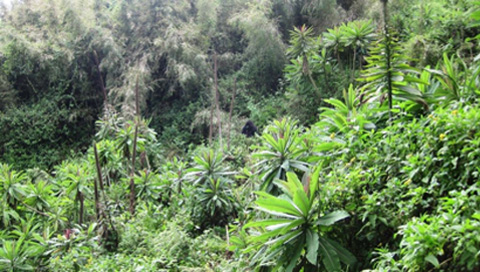 There are about 15 gorillas in this picture but we can only see one. Very difficult to find Turimaso!
There are about 15 gorillas in this picture but we can only see one. Very difficult to find Turimaso!
Dr. Jean Felix and 2 trackers accompanied me as I carried the pistol under my jacket and the pole behind my back. The gorillas know exactly what they are, and it would not be good for them to know what was about to happen. Turimaso was in a good spot – on flat ground, in a bamboo thicket, with no other gorillas visible. Dr. Jean Felix and one of the trackers stood between me and Turimaso as I loaded the dart into the barrel. It should be an easy shot – she was not moving and had her side to us, about 7 meters away. But I have darted enough animals to know that ANYTHING can happen, so my heart was racing. I crouched behind Dr. Jean Felix and the tracker, and slid the barrel between them. I lined up her thigh, squeezed the trigger, and suddenly it was done. The dart went of, she did not scream, and we hunkered down to wait quietly.
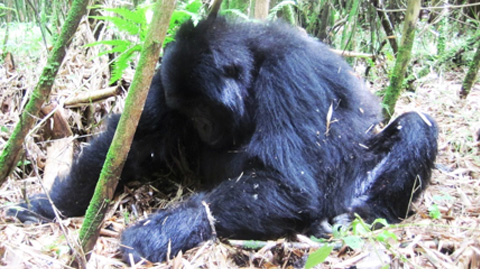 Turimaso with snare, going to sleep.
Turimaso with snare, going to sleep.
Turimaso walked off a ways and lay down. Within 10 minutes we had her on the tarp and were cleaning her wounds. The snare came off easily, but had cut her wrist deeply. She had a very deep laceration on her elbow, no doubt obtained just before we anesthetized her during the last bout of screaming. She also had obvious defensive wounds on the back of her right hand. We cleaned all the wounds, and sutured the serious wound on her elbow. We collected blood, various swabs, and were about to weigh and measure her when she sat up. She was still groggy, but we were clearly done with our procedure. As she was stumbling off I administered the reversal drug in order to speed her recovery, and Dr. Jean Felix administered antibiotics in an attempt to keep the deep wound from getting infected.
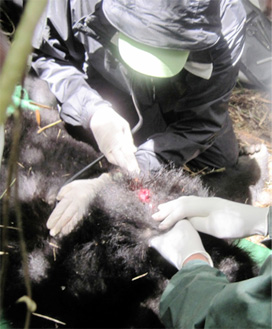 Turimaso had a deep laceration on her elbow that needed to be sutured.
Turimaso had a deep laceration on her elbow that needed to be sutured.
The next hurdle was getting her successfully back into the group. They had not moved far, but we needed to be sure she could find them. As she recovered she began making a cooing verbalization that was a contact call. We heard a chest beat in the distance and she moved in that direction. At this point only the trackers stayed with her, and in about 30 minutes we heard on the radio that she had found Cantsbe, and was eating with him. Now we could relax! Mission accomplished! Trackers will watch her closely for the next few days, and Dr. Jean Felix or I will do a visual recheck next week. My only worry at this point is the potential for infection in her arm. Fingers crossed.
We packed up our equipment and headed down the mountain. The mood was lighter and people were talking and joking as we went. Suddenly everyone stopped – I could see Fundi, one of the senior trackers, moving off into the forest. A snare. He had found a set snare. I could barely make it out, it was so well hidden. Felix sprung that one just as Damaciel, one of the other trackers, found another. We were right on a gorilla trail – this was bad. We radioed the ranger patrol to tell them they need to search this area, and learned that they had found 13 more snares in the area where Turimaso got hers yesterday. They will come up again tomorrow and patrol the area we were in today. As we walked down the trail I could see the trackers eyes surveying the forest. I wish I could see what they see. These guys really, really know the forest.
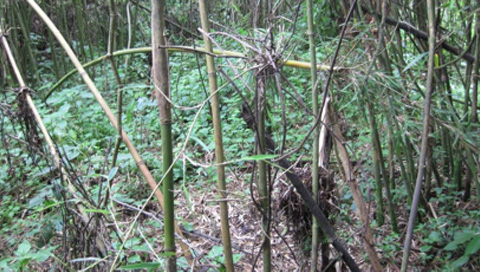 Here’s the first snare we found. Very well disguised.
Here’s the first snare we found. Very well disguised.
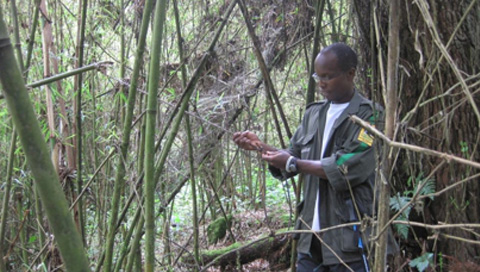 Felix tripped that snare and removed the rope.
Felix tripped that snare and removed the rope.
Felix explained that around Christmas is one of the heaviest snare times of the year. People want extra food for their Christmas meal. I have such mixed feelings – anger after having just treated this innocent little gorilla for a terrible wound directly related to the snare, and compassion for the people who are hungry and going to the forest for that extra bit of food. People around the forest are very poor. Community development is a HUGE part of gorilla conservation, but is a difficult job. We will continue our efforts through development of our farm partners, and little by little we will make a difference. Buhoro buhoro, in Kinyarwanda. Slowly slowly.
Dr. Jean Felix and I finally got back to MGVP Headquarters at 3:30, and now it was time to process the samples. Noel, our new lab technician and I worked until 6:00 spinning blood, making slides, labeling samples, putting them in liquid nitrogen, and cleaning up. It was a long but rewarding day. My first intervention. So far so good. Now we wait, and hope her wounds heal well. I really felt like a Gorilla Doctor today.
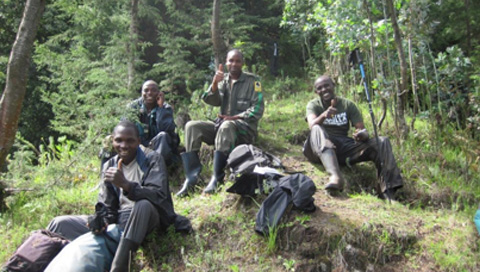 Everyone was relieved as we walked out of the forest!
Everyone was relieved as we walked out of the forest!
Help the Gorilla Doctors.


 Donate
Donate